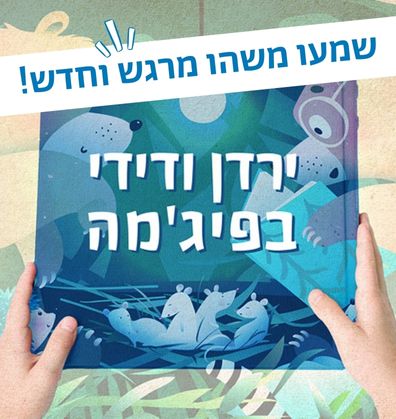מְקוֹרוֹת וְתַרְבּוּת
סיפור עממי
סיפורי מעשיות עממיים סוחפים אותנו לעולם מלא צבעים, ריחות, מראות נושנים וכמובן חוכמה עתיקה שלא נס ליחה לעולם.
סְּפָרִים
Book-Related Family Activities
The Wise Men of Chełm
Chełm is a city in Poland, and in Jewish folklore, it is the hometown of the wise men of Chełm, who are not actually all that smart: they are ridiculous and naïve, and their stupidity is often depicted with a smile and much compassion. The wise men of Chełm have become known for their silliness and pointless actions, and are the protagonists of many amusing tales. The term “wise men of Chełm” has come to mean those who act irrationally and absurdly. The stories about the wise men of Chełm can be found in collections and anthologies for both children and adults.
Reading & singing
The story about Joseph makes us smile and laugh. You could ask your child: What amused you about this story? What about the illustrations did you think was funny? What usually makes you laugh?
Inspired by Joyful Joseph, who began each morning with a song about his beautiful life, you too could write a song and tune, and sing it together.
Landmarks
What about your town do you like? You may enjoy taking photographs of places and people you love, or write a short poem about your hometown, using Joseph’s song as inspiration. You could even write a tune and turn your poem into a song.
How will we remember the way? You may want to step outside, look around you, and identify landmarks, such as a tree, bench, or the name of a street. You could draw a map of the route you’d walked, add your landmarks to it, and take it with you next time you set off on your way.
How beautiful is my town and how lovely is my room!
Joseph loves his town and looks kindly upon it. Try to follow Joseph’s footsteps and describe your room – what about it is beautiful and good? What do you love about it? And what do you like about your home? You could take a family tour, during which each of you will describe your favorite parts of the house.
A language of signs
An arrow pointing right, an arrow pointing left, one pointing forward, and another pointing backward – that’s all you need to create a particularly energetic game. You could draw these arrows on dice or directly on the floor, and ask your child to jump in the direction to which the arrow points. You could also throw number dice and jump up and down as many times as shown by the dice.
How about playing “treasure hunt”, and drawing arrows leading to the sought-after treasure?
Leah Goldberg
Leah Goldberg (1911–1970), born in Kaunas, Lithuania, was a poetess, authoress, translator, professor, and editor, while also heading the Comparative Literature Department at the Hebrew University of Jerusalem. At the age of 23 she had completed her PhD on Semitic Linguistics in Germany, and upon immigrating to Israel in 1935, began to publish her writings, and soon became a well-loved and well-known poetess. Her publications, and among them her children’s stories and poems (Apartment to Rent [Dira Lehaskir], Magic Hat [Kova Ksamim], What do the Does do? [Ma Osot HaAyalot?], and many more) have become invaluable gems of Israeli literature. In 1970 she was awarded the Israel Prize for Literature; however, having unfortunately passed away several months prior to the ceremony, her mother received it on her behalf.
Enjoy reading and discussing the book together!
Family Activities:
- You may want to huddle together, leaf through the book, and ask your child to look for what each character received in exchange for the nuts. Pay attention to the facial expression of those receiving the nuts. Perhaps you could look in the mirror, and see what you look like when you smile with joy.
- How about looking for puppets or toys who could represent the dwarf, squirrel, lumberjacks, prince, princess, and child, and give a puppet theater rendition of the story together?
- Were you surprised by the ending? Perhaps you would like to make up your own, and illustrate it.
- The characters in this book sing when they are happy. What do you like to do when you are happy?
- Do you know any other stories or poems by Leah Goldberg? You could go over to the bookshelf at home or the local library, and look for some, such as The Scatterbrained Man from Azar’s Village (Hamefuzar miKafar Azar), Apartment to Rent (Dira Lehaskir), or The Bad Boy (HaYeled HaRa).
- The nuts in this book are magical: “whomever discovers their secret will be the happiest in the world”. You may want to share with one another what makes each of you happy. Are the same things that make you happy make your child happy too? Perhaps you can think of a family member or friend who you can surprise with something that will make them happy. How about making them some home-baked nut cookies?
Golden nut cookie recipe
Ingredients:
1.5 cups of flour
0.5 a cup of chopped nuts
150g of butter
100g of powdered sugar
1 teaspoon of vanilla extract
0.5 a teaspoon of powdered coffee
Method:
- Pre-heat your oven to 180 degrees
- Mix all the ingredients into dough and cool for an hour
- Roll the dough into nut-sized balls
- Place them on a lined baking pan and bake for 10 minutes
- Cool and store in a sealed jar
Proposed Family Activities:
The illustrations demonstrate the clutter and noise in this house. You may enjoy looking through the book together, and finding what is misplaced and funny on each page. You could also compare the picture of the house from the beginning of the book to the one after the goat had been removed. What are the similarities and differences between the two illustrations?
Shimon’s house is not only crowded, but noisy too. You could demonstrate this to your child in the following way: turn on the TV or radio, and gradually add some of the sounds mentioned in the story. One of you could moo like a cow, another could make chicken noises, or a goat’s… until you will no longer be able to hear the TV or radio. Stop making all the animal noises at the same time, and discover just how quiet the room has become.
This story is the origin of the expression Lehotzi et Haez (“to remove the goat”), meaning to cause tremendous relief by removing something unnecessary. Is your house crowded? Does your child have any unnecessary “goats” in their schoolbag or pencil case? Try to find the reason for the clutter in your home – perhaps the drawers are full of old toys, clothes, or shoes that are no longer needed? You could tidy the house up together, and donate some of the things you no longer need. How did you feel once you removed the “goats” from your home?
Shimon and his wife go to their rabbi to seek his advice. Talking is helpful. Who do we turn to when we need advice? Who helps us solve problems? You could share some unexpected advice you may have received with your child that had proven helpful.
You may enjoy discussing a change of perspective with your child. Sometimes we cannot change reality, but are capable of changing the way we view it. Together, you could think of times when a change of attitude led you to see things differently. For it is those who are content with their lot that are truly rich.
Humor and folk tales
It’s Crowded at Home is a folk tale that takes place in a Jewish shtetl. The message of the story is conveyed humorously, with no direct preaching. The amusing tale of the goat, like many other humorous stories in Jewish tradition, remind us of that valuable life lessons are best learned with a smile!
Enjoy reading and discussing this book together!
Proposed Family Activities:
- The book contains many tales, and need not be read in its entirety in a single sitting, nor in order. You may want to suggest that your child select one fable at a time, and then proceed to read it together, and discuss it. Use the title and illustrations to help you select the story. What were you able to take away from the fable to your own life?
- Every community originated in a different country, and each brought with it fables and tales. Is there a certain story you had heard from your grandfather or grandmother? A tale passed in your family from one generation to the next? You may want to continue this generation chain, and tell it to your child.
- Perhaps you would like to pick a story and act it out. You may enjoy using relevant costumes and props.
- You may want to open an atlas or look for the world map online. Can you find where each story came from? Do you know of any other traditions followed there? Perhaps you know some dishes or outfits characteristic of that country, which you would like to demonstrate to your child through videos or images. Do you know a family who immigrated to Israel from that country?
- You could write your own fable together! Perhaps you would like to begin by thinking of a moral which you would like to convey through the story, and invent a tale that tells it.
- Which stories in this book are your favorite, or your child’s? You may enjoy making an illustrated book of fables your family particularly likes, and finds significant.
Activities You Can Do at Home
- Flip through the book, paying particular attention to the illustrations by Shai Charka. How did the illustrator choose to depict the behavior of the people of Chelm? You might ask your children to suggest other ways that the people of Chelm could have conveyed honor and esteem for their
- What makes you laugh? The Chelm stories paint human behavior in a ridiculous and amusing light. Similar tales — about Jucha, Hershele, and Chusham — appear in different cultures. Do you know any stories about these characters? You can look at home or at the library for more collections of humorous folktales and share them with your
- Spread a towel or rag on the floor, to symbolize the mud in Chelm’s streets, and use simple costumes and props (shoes, hats, scarves) to act out the
- The people of Chelm look for a way to distinguish the king from the rest of the townspeople, because it’s important that he “be honored at his full value.” After you read the story, discuss the value of deeds vs. status and honor. Ask your children what they think makes someone worthy of being honored?
- After reading the story, your children could try being “King for a Day.” A pretty scarf or shawl can be made into a robe; they can borrow mom’s or dad’s shoes; you could work together to make a crown. How does it feel to be like the king in the story? How do the onlookers (you–their parents!) honor him?
Activities You Can Do at Home
- Discuss together the fox’s behavior: do you think it paid off? Was there some other course of action he might have taken, without going hungry and getting so thin — twice?
- Flip through the book and ask your children to tell you the fable using only the pictures as a guide. Pay special attention to the details the illustrator added – for example, what is the fox dreaming about? What other animals appear in the pictures but not in the story?
- The fox really wanted those grapes and was willing to go to tremendous lengths in order to reach them. You might talk with your children about something they might really want, and about what sort of effort they’d be willing to invest to obtain it. Do you know any other fables? The original story appeared in Midrash Kohelet Rabbah, and was included in Haim Nachman Bialik’s Book of Legends, which anthologized hundreds of fables from the Talmud and Midrash. You can find lots more fables and stories of our sages online: in Hebrew at http://agadastories.org , and in English at http://www.chabad.org/library/article_cdo/aid/112670/jewish/Fables-Parables.htm.
- The fox “stars” in many tales and fables. You might discuss with your children the fox’s sly and clever nature. Do you know any other stories featuring a fox (for example, “The Fox and the Chickens” by Haim N. Bialik, or other fox fables)?
- Your children may act out the story using a doll or stuffed animal. When the skit is finished, you can offer both actors and audience bunches of grapes for refreshment!
Activities You Can Do at Home:
- “Who is respected? Those who respect their fellow creatures” (Pirkei Avot 4:1).The wedding guests learn an important lesson from Marco about treating people with respect. In keeping with the saying “Don’t judge a book by its cover,” you could talk with your children about external and internal qualities. Together, you might discuss traits and characteristics of the different members of your family, emphasizing the importance of treating every person with respect regardless of how he or she looks or is dressed.
- You might flip through the book together and compare the illustrations where Marco is simply dressed to those where he is wearing his elegant silk coat. Does “Marco remain Marco”?
- While reading the story, you could linger over the page where Marco “feeds” his coat food from the wedding feast. Does this illustration make your children laugh? Do you find it funny? You could ask your children why they think Marco decided to put food in his coat pockets.
- The story describes how the Jews of North Africa used to celebrate joyful life cycle occasions. You could talk with your children about weddings and other celebrations in your community today. How do you dress for them? What foods do you eat? Are there any special songs and dances associated with these events? Have your children ever taken part in a wedding or other life cycle celebration? See if you can find photographs from past happy occasions, and recall details from a wedding or other celebration in which you took part.
- You could dramatize the tale using puppets or stuffed animals, or put on a skit based on the story. Make sure to find appropriate costumes: some ragged outfits, dark make-up, fancy wedding clothes, an elegant coat, and so on.
- “When you eat the labor of your hands, you will be happy and it will be well with you” (Psalm 128:2). Marco works as a coal-seller—a job that barely paid enough to eat, and one that no longer exists. You could tell your children about coal, how people used to heat their homes with it, and how the job of coal-seller was regarded in society. Then you can ask your children what jobs or professions they know. If you like, you could tell them about the work that you do. What do you love about your work? What gives you satisfaction?
Family Activities
- Talk with your children about the two protagonists in the story, Balthazar and Joseph, and compare them. Balthazar has much treasure at home but doesn’t share his wealth with others, whereas the impoverished Joseph is content with his lot in life and opens his home to guests on Shabbat.
You may want to discuss the difference between being “thrifty” and being “stingy” (both terms used in the story), and talk about the kind of generosity that doesn’t depend on having money.You might also discuss the concept of envy, and ask your children why they think Balthazar was so determined that his treasure not fall into Joseph’s hands.
- Using simple props (you could make a precious “diamond” out of a crumpled ball of aluminum foil, and use a towel or scarf for a turban), you could dress up as the characters in the story and put on a family play. You could also use dolls, puppets, and stuffed animals to put on a show about this story.
- Joseph’s daughter goes with him on his trip to the market. Where do you do your shopping – at a farmers’ market, or at the supermarket? A visit to a bustling farmers’ market can be an enjoyable adventure for young children. You could work together to write and illustrate ashopping list for Shabbat, and then look for them in the farmers’ stalls at the market, or at the store.
- After reading the story, you can talk with your children about the way your own family celebrates Shabbat. What does your family do that is special? Who are your guests? You might work with your children to make an album of photos and drawings: “Our Shabbat,” featuring the people and things that make the Sabbath day special in your family.
- Do you, like Joseph and his family, enjoy hosting or being a guest on Shabbat? Many children enjoy taking part in the preparations for entertaining guests into their home. They can make a “Welcome” sign and hang it on the front door, help set the table, help with kitchen chores, or decorate the table with special drawings for each place setting.
- Many sources tell us about the unique character of Shabbat and the preparations for the day. Together, think of all the songs and stories you know about Shabbat (for example, “Who Loves Shabbat” by Ehud Manor; “Chanaleh and the Sabbath Dress” by Yitzchak Demiel; “The Missing Spice” arranged by Devorah Omer; etc.).
- Do you know a different version of the “Joseph Who Treasures Shabbat” story? If you do, you can share it with your children and compare the differing versions.
- The illustrations on the final pages of the book tell us, without words, what happens at the end of the story. Look at the illustrations together, and then use your ownwords to describe what happens after Joseph buys the big fish in honor of Shabbat. Notice the many figures that the illustrator added to the pictures throughout the story, and maybe invent a dialogue between these gossiping bystanders and Joseph.
Have fun reading and talking about this book!
Activities:
- Tell your child a family story – one that is funny or special – that is worth preserving as family legend: for example, a story of your childhood. Include details that say something about the place and time when the story took place. Look in a family album together at places where your child’s grandparents grew up and point out aspects of the past, such as: “Here is the bakery of your great grandfather that made the best challah in the world…”
- Travel back in time: To prepare for time travel back to Joseph’s village, look together at the illustrations in the book and encourage your child to identify items in his world. You can ask leading questions, such as: What does Joseph have in his house? What animals roamed around his neighborhood? Were there any buses there? What did people wear? In short: Was his world similar to ours? No? In your child’s opinion, why or why not?
- The fun of traditional sayings: The saying “When a coat is old, only its holes are new” is framed on the wall in Joseph’s house (see the page which begins, “Joseph had an old vest…”). The saying reflects Yiddish humor. Make a similar wall hanging with a saying that comes from your family or from your heritage. Who used to say it and on what occasions? Write the saying out and let your child make illustrations around it.
Eze’hu Ashir? Ha’sameach Be’chelko (Who is rich? He who is happy with his lot.)
In the Ethics of the Fathers (chapter 4), it is written: “Who is rich? He who is happy with his lot.” This proverb teaches that happiness is not measured in things or money, but rather in our ability to enjoy what we have. Although Joseph is poor, he is rich because he knows how to enjoy every “new” item of clothing he creates from what has worn out.
Activities:
- Look at the pictures and follow Joseph’s moods. When and why is he sad? When and why is he happy? What is his mood at the end of the book? How does your child explain these moods?
- Create two lists with your child: one of things that made him happy today and one of things that bothered him or made him sad. Look at the list of sad things and try to find something positive in the sad. In the evening just before your child goes to bed, you can make a habit of exchanging a list of the good things that happened to each of you that day.
Bal Tashchit (Respect for Existing Resources)
The mitzvah of bal taschit which appears in the Torah (in Deuteronomy) prohibits destroying a fruit tree even during a siege on a city. Over time a broader interpretation has come to prevail, to avoid destroying anything which can still be useful. Joseph’s Wonderful Overcoat takes place in a time when resources were scarce and people had to make good use of everything they could. Joseph found creative ways for re-using his coat. Today, in our era of abundance, there is an increasing tendency to try and re-use things to prevent harming the environment. This book provides a good opportunity to discuss with your child ways of limiting harm to the environment.
Activities:
- Ask your child to identify items at home whose use has changed over time and are used for something different: for example, a cracked plate that is used under a plant, a cup that is used for flowers etc.
- Talk to your child about the concept of wasting: What does it mean to waste? Do we throw away things that we could still use? What can we do to limit wastefulness?

Family Activities
- Feathers in the Wind is an ancient story passed from one generation to the next. Do you know any stories that are passed down in your family? You may want to remind each other of one or two such stories.
- Things told “by word of mouth” can sometimes get distorted. “Chinese Whispers”, or “Telephone”, is a game that demonstrates this possibility in a humorous way: players form a circle, and the first player whispers a word in the second player’s ear. The second then whispers what they heard to the third, and so on, until the final player is reached, and asked to repeat the word out loud. Is it the same as the one whispered by the first player?
- The woman in the story learned that it is not easy to mend her ways and take back the words she had said. You may like to discuss the following with your child: In your opinion, why did the woman gossip and spread rumors about the people of her town? Have you ever regretted anything you’d said, even as a joke? Perhaps you would like to discuss such incidents, and the steps you took following them.
- What is the connection between words and feathers? You may want to ask your child: What do you think of the rabbi’s unusual suggestion, given without any direct preaching? Are there any life lessons in your family that are passed on in a creative, humorous fashion?
- The verse “Guard your tongue from evil, and your lips from speaking guile” has a wonderful tune composed by Baruch Hayyat. If you know it, you may enjoy singing it together.
- Shlomo Abbas has written and retold numerous stories. You may want to look for more of his books at home or the local library, and read them together. Which stories did you like?
Enjoy reading and discussing the book together!
Family Activities:
- The illustrations by Uri Shulevitz remind us of a lifestyle from a different time and place. Talk about this with your children: If the story were to take place today, what would be different about the illustrations? You may want to prepare an illustrated booklet together of the same story, drawing pictures of the background and environment that is familiar to them today.
- The tale doesn’t reveal what the treasure was that Yitzhak sought or why he had to leave his home on a journey that brought him right back to the place where he started. It would be interesting to discuss this with the children and to hear their thoughts on the subject.
- This is an opportunity to share with your children the accomplishments that you have achieved after many efforts and great endeavor, and the sense of success that accompany these accomplishments. It is worth listening to their ambitions and dreams, too, and important that you encourage your children to try to realize them.
- Your children are invited to lead you on a journey of hidden discovery throughout your home. Close your eyes or tie a handkerchief around your eyes, and let your children lead you to places and “treasures” hidden about the home that you didn’t even know existed. The children can also give you household items and objects to feel. Are you able to recognize what they are? At the end of the journey, trade places, and lead your children around the house.
- Go on a treasure hunt – at home! You can hide a small “treasure” within the home. The children’s task is to look for it through the help of notes on which you have drawn hints and signs. The children will be happy to follow the hints that you have prepared, and to pass through different places in the home until they find the treasure.
- “Sometimes a person has to walk a long distance in order to discover what was in fact right nearby”: Have you ever noticed your children’s joy in discovering the nice, familiar feeling of
home upon returning from a trip or a vacation? What are the “treasures” in each room of the home? What makes each one of you happy when you return home? - There are “treasures” in the vicinity of your home, too, that the children will be happy to discover and to collect. It would be fun to go on a “discovery excursion” in your neighborhood. You can select a suitable “treasure” together to bring home, and you may even want to dedicate a special corner of the children’s room to “treasures”.
- “The Treasure” is the last book that will be distributed this year in the “Sifriyat Pijama” program. The school year is ending, and with it, your children will set off on a journey – whether they continue on to a new kindergarten or to school, or whether they remain in the same kindergarten and join the group of older children. This story reminds us that every journey brings with it a renewed appreciation of the treasure that is always with us, at home and within the family. Have a wonderful vacation from Sifriyat Pijama!
Classroom discussion and activity ideas:
- “Strange, what is happening here?” the beggar asks. You might want to stop the reading mid-way and allow the children to express their thoughts and opinions: What is happening in the town? Why does no one invite the beggar into their home? The children can take turns pretending to knock on the doors of the townspeople and ask them, “How are you? Why aren’t you opening the door to the beggar?” The children can invent different responses that the townspeople may give.
- Young children should not open the door to a beggar, or to any stranger. In today’s world, we need to warn children against opening the door to strangers. What is the best way to help others? Discuss the ways in which we can help others without inviting them into our homes. Think together how and whom children can help.
- After eating the soup, the townspeople sing, laugh, and dance. They even invite the beggar to sleep in their homes. Re-read the description of the townspeople together. What did the townspeople gain from their contribution to the soup that made them so happy? Try to think of a case when something new and better is created as a result of every person giving up something.
- Draw or paint a community center (real or imaginary) on cardboard. Cut the picture to create a jigsaw puzzle, which can then be put together. Show the children how each piece of the puzzle helps complete the picture.
- Prepare Bone Button Borscht with friends (but without the buttons!): You might want to divide the kindergarten children into groups of three or four, each of which would prepare soup at the home of a different child. Ask each group to write and illustrate their soup’s recipe, and compile a classroom soup cookbook.
- Prepare soup in the classroom: Ask each child to bring in a vegetable or a spice, to ensure that everyone takes part in contributing to the group effort of preparing the soup. The recipe of the soup prepared in kindergarten can be the first one to appear in the kindergarten’s cookbook described in the previous activity suggestion!
- In order to bring the abstract concept of a “community” closer to the children, start with the joys of being a part of our kindergarten community:Who is a part of it? What do we like to do together? What do we do together that we can’t do alone? What special or added value do we achieve by being a community as opposed to each person being alone in his or her home? What other thoughts do you have on the topic?
- One idea for solidifying the feeling of community is to sing with the children the song “HinehMah Tov U’MahNa’im, ShevetAchim Gam Yachad” (How goodly and pleasant it is for brothers/friends to sit together).
- Community institutions: Suggest to the parents that they take a walk with their children in the neighborhood in order to take specific note of the community institutions in it (community center, library, school, synagogue, etc.), and afterwards to draw these buildings. Ask the children to bring their drawings to the kindergarten. By hanging the children’s pictures on the wall, you can create a model of the actual community and its institutions, or even an imaginary community. Or, you may want to build a model of such a community by using blocks, Lego or some other construction material.
- What can five buttons achieve? Divide the children into two groups. One group draws a collective picture of the darkened town (houses, inhabitants) as it was when the beggar arrived in the beginning of the story, while the other group draws pictures of the town after the people ate the soup together. You can hang the two pictures on a bulletin board on the wall in order to emphasize the change.
- “Receive everyone with a kindly countenance” [Haveimikabel et kul ha-adamb’severpanimyafot(Avot, 1)]: At an in-service-training workshop, “Tali” kindergarten teachers discussed the difference between “Bone Button Borscht”, and Jewish tales that deal with the importance of receiving people with a kindly countenance and the mitzvot of welcoming guests (hachnasatorchim). The behavior of the townspeople in Bone Button Borscht demonstrates the exact opposite of welcoming guests and of “receiving everyone with a kindly countenance”.
Receiving guests is one of the most important and beloved mitzvot of the Jewish tradition. In the Book of Genesis (ch. 18), it is told how Abraham welcomes three strangers, feeds them, and invites them to stay as guests in his tent. Abraham’s behavior teaches us how we should behave in our homes.
- During the holiday of Sukkot it is customary to invite guests (“Ushpezin”), and for people to visit one another in their sukkot. And each year on Passover we invite guests to a meal and read: “Koldichfin yeti v’yachol, kolditzrich yeti v’yifsach” (Every hungry person may come and eat, every one who is in need may come and observe). We invite others to come and eat with us, in order that no one remains outside, hungry and alone on the Seder night.
- You can share with the children the tale relating that in the tents of Abraham, our forefather, the first Jew, there were four openings. Each opening opened out to a different direction in order that every guest, no matter where he came from, would feel comfortable to enter.
- How do we host a friend? What is the duty of the host or hostess, and what is the duty of the guest? Accepting guests is part of the everyday life of children, but sometimes it’s difficult for them to host because they don’t know what to do with the guest, or because it is difficult for them to share their possessions. You can take such an opportunity for discussing the ways in which to make the guest feel comfortable.
- The mitzvah of welcoming guests is most meaningful when inviting one who is needy. You can carry out a “campaign” in the kindergarten in which every child invites a new friend, someone who has not yet visited him or her at their home. This is an excellent opportunity for creating new connections between children, and to help children who have difficulties with social skills.
- “Bone Button Borscht” is distributed in the month of Adar. Purim is approaching, and with it, mitzvot that are directly connected to community action and to helping the needy – mishloachmanot and gifts for the needy. As a class you can prepare mishloachmanot for all members who serve the community (security guards, the kindergarten staff that works in the after-school/afternoon program, etc.). You might also organize gifts for the needy. Your classroom community can collect and organize food, games or any other useful items that come to your mind that could gladden the hearts of those who in need.
Look at the illustrations together
You may like to look at the illustrations together, where many details appear that are not mentioned in the story. What do the siblings like to do while their father works in the field? What are the animals in the story doing? Perhaps you’d like to find the illustration where the father tells them he does not remember where the treasure is buried. What do the children imagine finding there? You may want to ask your own child what they regard as a “treasure” and what they might have hoped to find in the field, had they been promised a treasure.
!Your child can work the land
Your child can work the land, even at home! Together you may enjoy making seeds sprout, or planting bulbs, avocado pits or potatoes, whether in a flowerpot or in the ground. Water it, look after it, follow its growth. It requires effort and cooperation, just like in the story – maybe in the end you’ll grow a “treasure” too?
!A treasure at home
A treasure at home! You may want to suggest that your child make their own treasure chest. You could hide the treasure in a room in the house and play “treasure hunt”. Draw illustrated notes with clues on them and help your child get closer to the hidden treasure from one note to the next.
Talk about the different roles in your family
The farmer’s three children work together, and each one makes suggestions and comes up with good ideas. Perhaps you’d like to talk about the different roles in your family: what is each family member good at?
"He who works his land shall have plenty of bread"
“He who works his land shall have plenty of bread” (Proverbs 28:19): In the field the brothers plough, sow, reap… in Hebrew there are many words that describe farming! You may like to look at the illustrations, and identify together which action is being performed in each one and compare the tools, then and now.
The story depicts the changing seasons
The story depicts the changing seasons: Does your child know which season is most suitable for sowing and harvesting? Which is yours and your child’s favorite season, and why? Perhaps you’d like to suggest that your child draw a picture depicting themselves in their favorite season.
Family Activities
- You may enjoy looking at the illustrations and looking for other funny things about Chełm. Have you noticed the square wheeled bicycle? Try to guess why the lady sitting on the bench is hiding under an umbrella.
- Did you find this story funny? Do you know other stories about the people of Chełm, or tales about Hershele and Juha? You may want to read them together, or simply tell each other jokes.
- Perhaps you’d like to look out the window and search for the moon. What does it look like? You could draw the moon you saw, and hang the drawing by the window. Then return to the window and look at the moon again several nights later – does the moon look any different?
- You may enjoy taking a nocturnal walk together. Does your street look any different at night? What do you see? What sounds do you hear? You could look up at the sky, search for the moon, be reminded of the people of Chełm, and laugh…
Who likes making crescent-shaped biscuits?
Ingredients:
100g of caster sugar
150g of butter
1 tsp of vanilla essence
1 tsp of lemon zest
2 cups of flour
1 flat tsp of baking powder
4 tbs of ground almonds
Castor sugar for sprinkling on baked biscuits
Instructions:
Mix the castor sugar and butter together in a mixer.
Add the vanilla essence and lemon zest.
Add the flour, baking powder and ground almonds, mixing it all together to form dough.
Take a piece of dough, roll it into a long, thin roll, and cut small crescent-shaped “tubes” out of it.
Place the little crescents on a cooking tray covered with parchment paper, and repeat until all the dough is used.
Bake in a preheated overn set to 175 degrees Celsius for 15 minutes, or until the edges of the crescents begin to turn golden.
Cool and sprinkle castor sugar.
Bon Appétit!
Enjoy reading and discussing the story together!

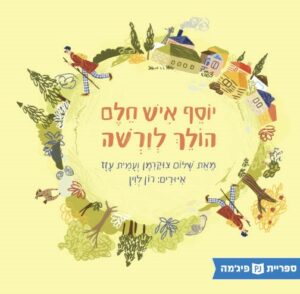 Joseph from Chełm goes to Warsaw
Joseph from Chełm goes to Warsaw 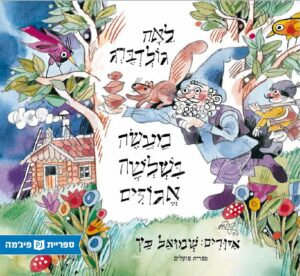 A Tale of Three Nuts
A Tale of Three Nuts 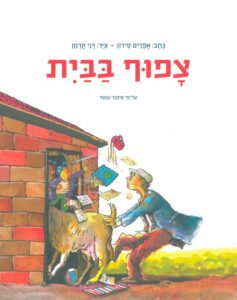 It’s Crowded at Home
It’s Crowded at Home 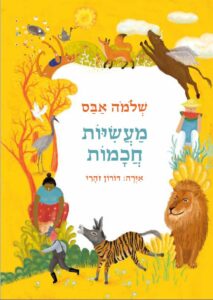 Tales of Wisdom
Tales of Wisdom 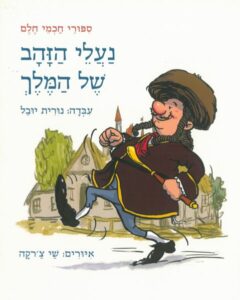 The King’s Golden Shoes
The King’s Golden Shoes 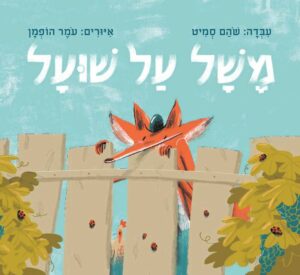 Vineyard
Vineyard 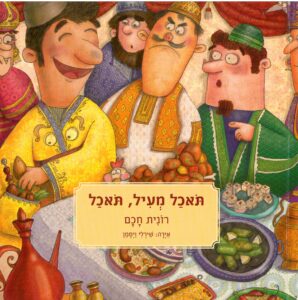 Eat, Coat, Eat!
Eat, Coat, Eat! 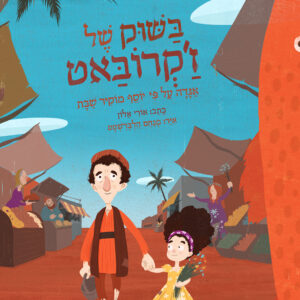 In the Market of Zhakrobat
In the Market of Zhakrobat 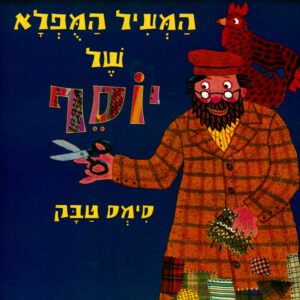 Joseph’s Wonderful Overcoat
Joseph’s Wonderful Overcoat 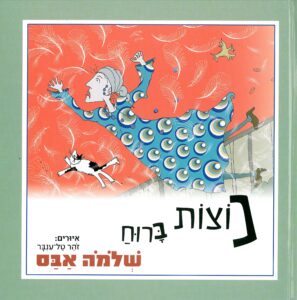 Feathers in the wind
Feathers in the wind 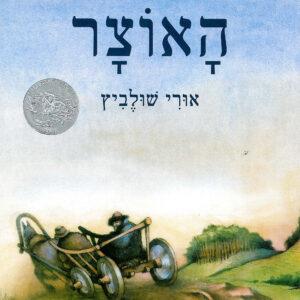 The Treasure
The Treasure 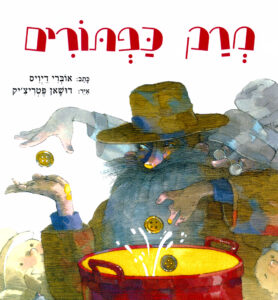 Bone Button Borscht
Bone Button Borscht 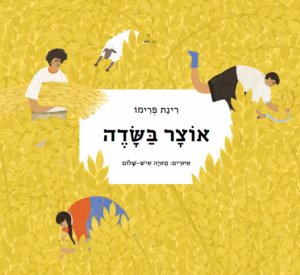 A Treasure in the Field
A Treasure in the Field 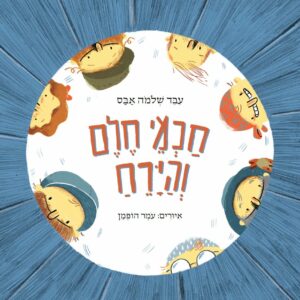 The People of Chełm and the Moon
The People of Chełm and the Moon 
